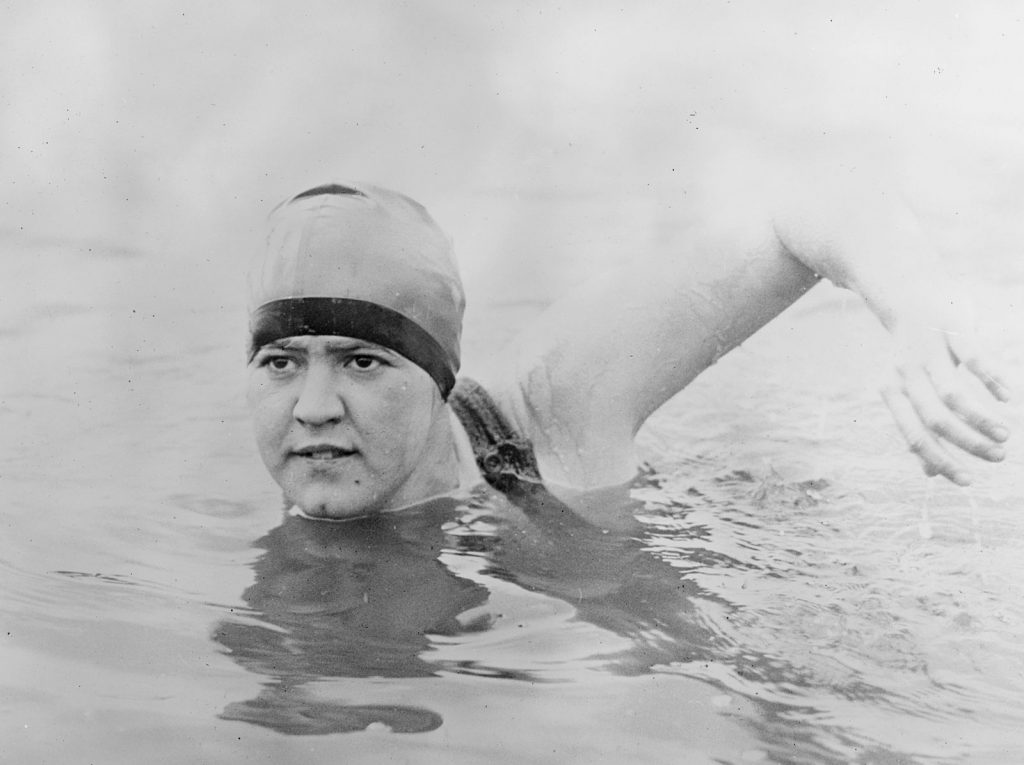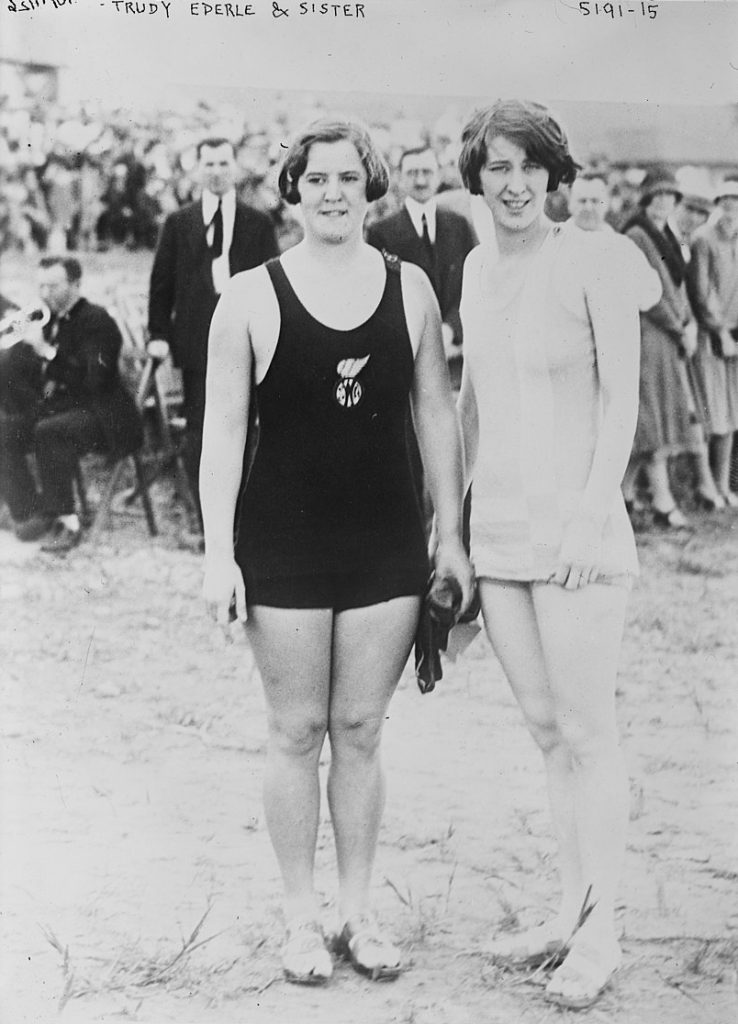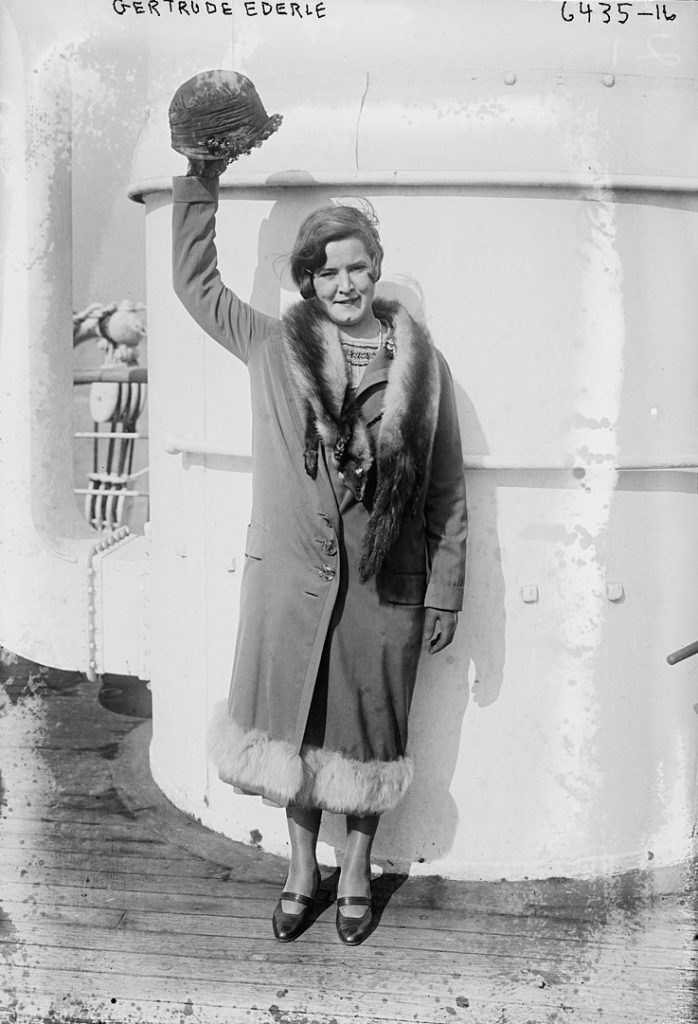TBT: Super Awesome People™ in History.
On August 6, 1926, 20-year-old Gertrude Ederle became the first woman to swim across the English Channel—and she did it in record time.
“‘The torments of seasickness, indigestion, inflammation of the eyes, great cold and other disagreeable features may prove too much for any woman swimmer.”
Jabez Wolffe, Ederle’s trainer, following her failed attempt to cross the Channel in 1925

Gertrude Ederle, 1925 (National Portrait Gallery/Smithsonian) 
Gertrude Ederle (Wikimedia Commons)
American swimmer Gertrude (“Gertie”/”Trudy”) Ederle was born on October 23, 1905. Her father taught her to swim in Highlands, New Jersey at the age of 9, and she later credited the “swift currents at the Highlands Bridge” for giving her the strength to conquer the powerful currents of the English Channel. She joined the Women’s Swimming Association in her teens and won her first championship at 16, becoming the Metropolitan New York junior 100-meter freestyle champion.
In 1922, Ederle set seven women’s world records in a single 500m swim at Brighton Beach, Brooklyn. Two years later, she won three medals at the 1924 Summer Olympic Games in Paris—a gold in the 400m freestyle relay and two bronzes (100m and 400m freestyle). She had been favored to win golds in multiple women’s events, but she was hampered by an injured knee and fatigue. According to her New York Times obituary, the female athletes from the United States were forced to stay far outside the center of Paris and travel five to six hours each day to practice in the Olympic pool, as “United States officials did not want them contaminated with (…) the city’s bohemian morality.”
After the 1924 Olympics, Ederle set her sights on becoming the first woman to swim across the English Channel—an athletic feat accomplished previously by five men, the first in 1875. In preparation for her Channel swim in 1925, Ederle swam a 17.5 mile course from the Battery to Sandy Hook in 7 hours, 11 minutes, setting a women’s record that held until 2006. An annual NYC swimming race named after Ederle (Ederle Swim) was first organized in 2006 and follows the same course she took in 1925. The day after her Battery-to-Sandy Hook swim, Ederle left for Europe, intent on swimming the Channel.
“Hundreds had attempted the arduous Channel swim before Ederle. Only five men had made it all the way. What Mount Everest was to climbers, the English Channel was to long-distance swimmers. Its cold waters were subject to powerful currents, wind and fog. It brimmed with jellyfish and Portuguese men-of-war and occasionally was visited by sharks.”
Susan Vanghn, Investor’s Business Daily (excerpt)

Gertrude Ederle and her sister (Library of Congress) 
Coach Bill Burgess and Ederle, 1926 (Le Miroir des sports) 
Gertrude Ederle (Library of Congress)
Unfortunately, Ederle’s first attempt at crossing the English Channel on August 18, 1925 was a failure. She was disqualified after swimming 23 miles in 8 hours 43 minutes when she was touched by someone in a support boat who thought she was drowning. Some suspected that she had been intentionally sabotaged by her then-swim coach Jabez Wolffe who had tried—and failed 22 times—to swim the English Channel himself.
But Ederle wasn’t ready to give up. She got a new coach, Bill Burgess, who had become the second person to successfully swim the Channel in 1911. She raised her own financing this time (after her first attempt was sponsored by the Women’s Swimming Association), and she had new motivation from her father, who promised her a red roadster if she made it across. Ederle had extra competition as well from other female swimmers who wanted to be the first across, and the press amplified the competition, with different newspapers backing different swimmers.
Three days after another American swimmer, Clarabelle Barrett, failed to cross after 22 hours in the water, Ederle began her swim at Cape Gris-Neze, France, early on the morning of August 6, 1926. She was smeared with grease (to protect against the cold and jellyfish) and wore a two-piece swimsuit and waterproof goggles of her own design. The English Channel is only 21 miles across at its narrowest point, but it took Ederle at least 35 miles of swimming to make it through the currents to the English shore. She swam across in 14 hours and 34 minutes, beating the previous men’s record (Enrique Tirabocchi—16 hours 33 minutes) by nearly 2 hours.
After her incredible feat, a ticker-tape parade was held in Ederle’s honor in New York City, with an estimated 2 million in attendance. President Coolidge called her “America’s Best Girl”, she received numerous marriage proposals (and at least one eponymous song: “Trudy”), and Gertrude Ederle was known as America’s “Queen of the Waves“. But her public fame was short-lived.
Ederle’s hearing had been impaired since a bout with measles when she was 5-years-old, and her grueling Channel swim exacerbated her hearing loss. She had a brief career in a touring vaudeville act, but suffered a nervous breakdown when she lost her hearing, and she retreated from the public view. She suffered a terrible fall in 1933 that left her in a cast for four years, and the pain from her injury never fully subsided. She spent many years teaching children to swim at the Lexington School for the Deaf in New York. Ederle retired quietly in Flushing, Queens, and later in Wyckoff, New Jersey.
Between 1921 and 1925, Gertrude Ederle held 29 U.S. national and world records in various swim distances. She held the women’s record for swimming the English Channel for nearly 25 years, until 1950 when Florence Chadwick swam it in 13 hours 20 minutes. Ederle passed away on November 30, 2003, at the age of 98.
“It was just that everybody was saying it couldn’t be done. Well, every time somebody said that, I wanted to prove it could be done. It took a Yankee to show them how.”
Gertrude Ederle, The New York Times
Read More About Gertrude Ederle:
- SWIMMING; A Pioneer Looks Back on Her Unforgettable Feat (New York Times)
- Gertrude Ederle, the First Woman to Swim Across the English Channel, Dies at 98 (New York Times)
- Gertrude Ederle 1926-1953 (Queen of the Channel)
- When Gertrude Ederle Turned the Tide (The Telegraph)
- The First Woman to Swim the English Channel Beat the Men’s Record by Two Hours (History.com)
- Ederle, Gertrude (American National Biography)
- Then and Now: Gertrude Ederle, First Woman to Swim the English Channel, Still Gets Fan Mail (New York Times)